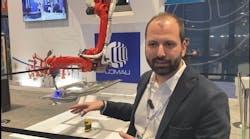- How are end users implementing stack lights on multi-station assembly lines?
- Why are operator buttons needed if an HMI can provide the same function?
- What are some of the best ways to indicate alarms and confirm that appropriate operator action has occurred?
- How do I indicate and describe alarms without overloading an operator with too much information?
Why are we still using stack lights, annunciators and push buttons? Are machine designers going for a retro look with these antiquated analog components? Or maybe it’s the hipster in them, wanting to show that they were building machines with interface devices before interface was cool. “That annunciator sounded way better on vinyl.”
Human-machine interface (HMI) can offer a digital version of almost any button, knob or light, but analog still has its place on machines, whether it’s for its ruggedness, for no-look interaction or for situations in which touchscreen operation isn’t an option.
We posed several questions regarding these time-tested components to a panel of industry veterans to see what light their experience and expertise might shed on the subject.
How can stack lights improve machine or system productivity?
Michael Day is industrial control products market development manager at Siemens.
Matt Newton, Opto 22: The biggest benefit stack lights provide to machine and system productivity is real-time situational awareness. For example, by using stack lights, operators can quickly discern the status of a machine without having to log in to an HMI and check alarms or system logs.
Matt Newton is director of technical marketing at Opto 22.
Thomas Putz is sales manager at Auer Signal.
Michael O’Neill is president at Werma-USA.
Zach Tinkler, Schneider Electric: By providing both visualization and sound annunciation from the top of the machine, a tower light is able to clearly indicate changes in machine state to all facility personnel within line-of-sight or sound range. This quick and easy indication can help ensure operators are alerted to changes as quickly, saving time and money.
Zach Tinkler is U.S. product manager, control and signaling at Schneider Electric.
Sopan Khurana is applications engineer at Patlite.
Will Healy III is marketing management director at Balluff.
Robb Weidemann, Banner Engineering: Modern stack lights can improve machine productivity by collecting and sending status and output information. Wireless stack lights are available with inputs to track downtime, pieces produced and scrap rates, and then they can send this information to a local controller for analysis and reaction. Making changes based on real-time data improves productivity and eliminates lags in response to issues.
Robb Weidemann is senior business development manager at Banner Engineering.
Lee Clore, Onyx Industries: A stack light acts as the first line of defense to call attention to a machine state. Stack lights are not intended to provide specifics, but rather communicate some form of immediate need. They are often bi-directional machine communication devices.
They communicate bi-directionally since they provide immediate feedback about machine state and often allow an operator to make a maintenance or supervisory call.
Machine feedback color coding at a stack light is generally categorized where green is good, yellow is a warning and red is bad. This visual indication of machine state feedback is fast, is easy to process and allows operators to make immediate decisions or take action. No matter where the operators are around the machine, they quickly become acclimated to looking at the stack light for immediate machine-state feedback.
Machine calls are often made using blue or clear/white color segments. Operators can initiate these indicators via hardwired controls or through an HMI. Lead-hands, supervisors and raw material suppliers use these visual signals to initiate some form of action. Often, there is a time-out function where a delayed response to an operator call will start the indicator-light segment to flash, letting personnel know they are behind in response.
Lean manufacturing has adopted stack lights with well-defined procedures making them integral to the process efficiency.
Productivity and safety are designed into a machine together when stack lights operate as awareness indicators. ANSI addresses this specifically relative to certain machine tools and area guarding. Some machine tools, such as manually operated plate rollers or automated lasers, may call for an awareness indicator to call attention to operation in a specified area. Stack lights are often used in conjunction with area safety scanners as awareness indicators when the defined warning area has been entered. Turning on a red light and actuating a buzzer alerts persons of a warning perimeter, with time to stop before they actually cause the safety circuit to trip. This keeps people safe and the machine up by avoiding unnecessary safety violations.
Lee Clore is owner/controls designer at Onyx Industries.
ALSO READ: Harsh environments call for more rugged components
Mike Bacidore is the editor in chief for Control Design magazine. He is an award-winning columnist, earning a Gold Regional Award and a Silver National Award from the American Society of Business Publication Editors. Email him at [email protected].















